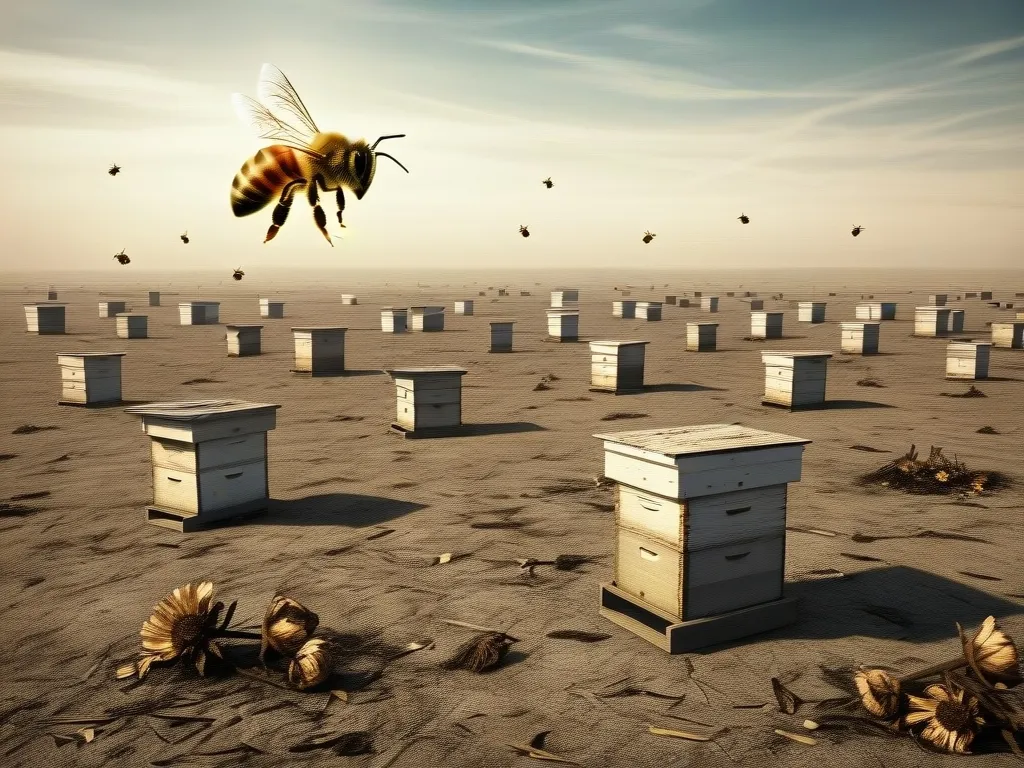The decline of the honeybee population has been a topic of intense scrutiny and speculation for years, with many wondering if there is more to the story than what meets the eye. As we delve into the mysterious world of vanishing honeybees, we find ourselves at the intersection of science, conspiracy, and environmental crisis.
The Mysterious Disappearances
It all began around 2006 when commercial beekeepers started noticing a disturbing trend: their honeybees were disappearing at an alarming rate. Beekeepers would open their hives to find them filled with honeycomb, wax, and honey, but eerily devoid of the bees themselves. This phenomenon was soon dubbed “colony collapse disorder” (CCD), a term that would become synonymous with the horror and mystery surrounding the bees’ disappearance.
CCD is not a new issue; similar events have been documented throughout history. In the early 20th century, beekeepers reported instances of “disappearing disease” and “spring dwindle,” where large numbers of bees would vanish from their hives. However, the scale and frequency of these events in the 21st century are unprecedented.
The Economic and Ecological Impact
The implications of CCD are far-reaching and devastating. Honeybees are crucial pollinators for a wide range of crops, including almonds, cantaloupes, cranberries, and cucumbers. Without these bees, agricultural productivity would plummet, leading to significant economic losses. In the United States alone, the value of crops pollinated by honeybees is estimated to be nearly $200 billion annually.
The almond industry in California is a prime example of how critical honeybees are. Almonds are the state’s most valuable agricultural export, and their production is entirely dependent on honeybee pollination. A shortage of bees could jeopardize this multi-billion-dollar industry, highlighting the urgent need to address the bee crisis.
Theories and Suspects
Several theories have emerged to explain the sudden and widespread decline of honeybee populations. One of the most contentious is the role of agricultural pesticides, particularly neonicotinoids. These chemicals, used on over 140 different crops and in home gardens, have been linked to bee deaths even at what are considered safe doses.
The story of a pest-control company spraying insecticide on Linden trees in Oregon, resulting in the death of an estimated 50,000 bumblebees, is a stark reminder of the dangers these chemicals pose. Beekeepers and environmental groups have been vocal about the risks, with some even taking the Environmental Protection Agency (EPA) to court over the approval of certain pesticides.
The Varroa Mite and Other Pests
Another significant threat to honeybees is the Varroa destructor, a parasitic mite that has been ravaging bee colonies since its introduction to the U.S. in the 1980s. These mites weaken the bees’ immune systems, making them more susceptible to diseases and pesticides.
Bacterial and viral diseases also play a role in the decline of honeybee populations. The chronic bee paralysis virus, for instance, has been identified as a factor in historical bee die-offs. However, the current crisis seems to be driven by a complex interplay of multiple factors rather than a single cause.
Ecological Manipulation and Corporate Interests
As we dig deeper, questions arise about the role of corporate interests and ecological manipulation. The widespread conversion of natural habitats into industrial agricultural fields, particularly those of genetically modified soybeans and corn, has created vast deserts for honeybees. These crops offer little to no food for bees, exacerbating the problem of malnutrition.
The Conservation Reserve Program (CRP), which sets aside land for conservation, has seen significant reductions in recent years. Farmers are opting to plant commodity crops instead, driven by higher profits. This shift has further reduced the availability of forage for honeybees, making their survival even more challenging.
Government Response and Controversies
The government’s response to the bee crisis has been multifaceted but often criticized for being inadequate. The formation of a task force by the EPA and the Department of Agriculture in 2013 was a step in the right direction, but many argue that more needs to be done.
Subsidies provided through the Farm Bill have helped the pollinator industry, but the root causes of CCD remain unresolved. The approval of pesticides like sulfoxaflor, despite evidence of their toxicity to bees, has sparked lawsuits and public outcry.
Secret Experiments and Conspiracy Theories
While the scientific community focuses on tangible causes like pesticides and parasites, conspiracy theories have begun to circulate. Some speculate about secret experiments or ecological manipulation by governments or corporations aimed at controlling the food supply or advancing certain agricultural practices.
These theories, though often lacking concrete evidence, reflect a broader distrust in the system and a sense that there might be more to the story than what is publicly acknowledged. The notion of a “second silent spring,” a term coined to describe the current environmental crisis, evokes a sense of urgency and mystery.
Personal Stories and the Human Element
For beekeepers like Bill Rhodes and Zac Browning, the decline of honeybees is not just a statistical issue but a personal and economic one. These individuals have dedicated their lives to caring for these vital pollinators, only to see their colonies disappear without explanation.
The emotional toll of losing bees is palpable. Beekeepers describe the experience as akin to a “perfect crime” – no bodies, no murder weapon, just the eerie absence of the bees. This personal aspect underscores the human connection to the natural world and the importance of finding solutions to this crisis.
Conclusion
The vanishing honeybee dilemma is a complex web of science, conspiracy, and environmental crisis. While the exact causes remain multifaceted and sometimes mysterious, it is clear that immediate action is necessary to protect these vital pollinators.
As we navigate this intricate landscape, it is essential to consider both the scientific evidence and the personal stories of those affected. The truth may indeed be stranger than fiction, but one thing is certain: the fate of the honeybees is inextricably linked to our own, and solving this mystery is crucial for the health of our planet.
In the end, the story of the vanishing honeybees serves as a stark reminder of our interconnectedness with nature and the urgent need for sustainable practices that protect both our environment and our food supply. Whether through science or speculation, the quest to save the bees is a journey we must undertake together.






